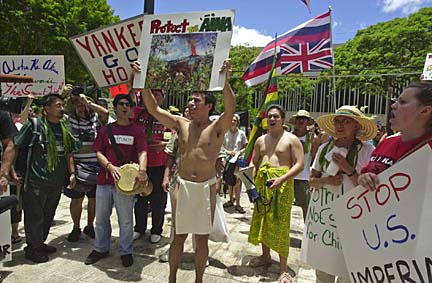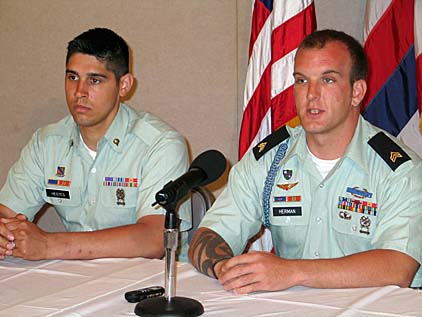
The 25th Division's 2nd Brigade will be the fifth of six units to use the Stryker.
Stryker gets
a green lightA final environmental report
admits to some adverse impacts
The Army's top man in the Pacific says it is not possible to alleviate all the impact to Hawaii's environment from 291 combat Stryker vehicles during the next three years.
"When the Army trains, we are going to have an impact," said Lt. Gen. James Campbell in discussing his decision yesterday to approve, after three years of study, the conversion of the 25th Division's 2nd Brigade to the fifth of six Stryker units.
However, Campbell said steps to mitigate damage to cultural, historical and environmental habit are in place. "We are going to minimize that impact."
Campbell's decision was quickly criticized by Hawaii activists worried about the environmental and cultural impact of transforming the Army's light infantry division to a unit based around new 19-ton, eight-wheeled armored vehicles.
"We're disappointed but we're not surprised," said Ikaika Hussey, a spokesman for the environmental group DMZ Hawaii/Aloha Aina. "Whenever the military uses land, it's been our experience that the land is lost."
The final environmental impact statement approved by Campbell yesterday acknowledged that there are "significant and unavoidable impacts" for which either no mitigation or partial mitigation is feasible. These include limiting access to some recreational areas, increased dust and noise pollution, and possible damage to historical areas at the Big Island's Pohakuloa Training Area and Dillingham Military Reservation.
DMZ Hawaii/Aloha Aina members rallied Tuesday outside the federal building, where they delivered a community impact statement to the offices of Hawaii's congressional delegates.
But Campbell said, "We are good stewards of this land."In addressing concerns of protesters who held signs yesterday outside Campbell's Fort Shafter headquarters, the three-star general said: "I sincerely respect your right to voice opposition to the Stryker brigade. ... I would ask you to reflect on the thousands of soldiers, sailors, airmen, Marines and Coast Guardsmen based in Hawaii who are putting their lives and their futures on the line around the world to protect your freedom and to ensure you have the right to voice your opposition."
In Hilo, activist Jim Albertini led a group of about 30 people picketing an Army news conference on the Stryker Brigade.
"America is long gone from defending people's rights," Albertini said. "It's about defending imperial power, (Vice President) Dick Cheney and the oil companies. I urge the troops to come home."
Campbell said the first of the 291 new eight-wheeled vehicles should arrive at Schofield Barracks in May 2006. The addition of 810 more soldiers to the Tropic Lightning's 2nd Brigade would start soon after the unit returns to Wahiawa from Iraq next spring.
Hussey, of DMZ Hawaii/Aloha Aina, said protesters were asking "for more critical dialogue on the Stryker Brigade, which the congressional delegation and military officials are approving without listening to the community's concerns."
He said that "families will be exposed to carcinogens and mutagens, that water will be polluted, that the state will bear the social costs of new families and children in the DOE (Department of Education) ... and that Hawaii will become a greater target from outside attack."
U.S. Sen. Daniel Inouye said Campbell's decision "is good news for Hawaii and the nation. By basing a Stryker brigade in Hawaii, our soldiers will be able to move swiftly to cope with any security threat in the Asia-Pacific region."
U.S. Rep. Neil Abercrombie added: "The Army went to great lengths in preparing the Stryker EIS. They're earmarking $40 million to monitor the impact on the environment; they've made a lot of changes to meet concerns raised during the EIS process; and they've had plenty of input from the community, scientists and public agencies charged with protecting the environment."
Campbell said there were 400 changes done to the final EIS because of the 2,000 concerns that were registered during the public comment period. These included changes to the training schedules to alleviate dust and noise problems.
The Army noted other initiatives such as a fire management plan, a continued propagation and outplanting program for endangered plants, a fencing plan to keep grazing animals away from endangered plants, and a protection program for archaeological and historical sites.
Campbell said the Army has spent $50 million on environmental and cultural mitigation in the last five years and will spend up to $40 million in the next five years to offset the environmental effect of fielding and training the Stryker combat team.
Although the Army plans to build several new firing ranges at Schofield Barracks for the Stryker unit, Campbell said the Army still wants Makua Valley as a live-fire training area for other 25th Division units.
With approval of the environmental impact statement yesterday, Ron Borne, head of the Army's transformation plans here, said the Army can start negotiations with Campbell Estate to enlarge Schofield Barracks and begin construction of new firing ranges there this fall. A total of 28 military construction projects are planned at a total cost of $693 million on Oahu and the Big Island.
Similar talks can begin to buy or lease 23,000 acres of Parker Ranch land, Borne said. The land would be used for maneuvering but no live-fire training.
Star-Bulletin reporter Rod Thompson and the Associated Press contributed to this report.
25th Infantry Division
www.25idl.army.mil
BACK TO TOP |
Spc. Christopher Hegyes, left, and Sgt. Benjamin Herman, members of the 3rd Stryker Brigade Combat Team, talked yesterday about using Stryker vehicles against insurgents in Iraq.
Iraq duty sells soldiers
on ‘quiet’ Stryker
The Army's new combat vehicle is far quieter than a city bus, says a soldier who has worked with Strykers in Iraq.
Army Sgt. Benjamin Herman, who was in Iraq for eight months with the 3rd Brigade Combat Team, told reporters yesterday that "people will be shocked when they hear how quiet" the 19-ton, eight-wheeled vehicle is.
The Stryker was the brainchild of former Army Chief of Staff Gen. Eric Shinseki, who is originally from Kauai. Shinseki's goal was to remake the Army into a more responsive force that could move quickly into battle rather than one centered around tanks that weigh three times more than the eight-wheeled Stryker vehicles.
Lt. Gen. James Campbell, U.S. Army Pacific commander, said the Army plans to bring three Strykers to Hawaii at the end of this month to answer critics who believe that the Stryker is as big and noisy as a tank.
He wants to put them on display for two days on Oahu and another two days on the Big Island where the Army wants to use the Pohakuloa Training Area as its major Stryker operations center.
Capt. Kathy Turner, 25th Infantry Division spokeswoman, said the Army hopes to be able to take the Strykers into communities such as Wahiawa "so people can get a firsthand look at them."
Herman, a Stryker vehicle commander, said he does not know of any Stryker that has been hit by a rocket-propelled grenade after the Army built a cage around the vehicle. However, he acknowledged that the cage makes it hard to maneuver the Stryker in Iraqi towns that have cramped quarters.
The Army said two Strykers have been lost in Iraq, and there has been only fatality, caused by a grenade.
Although Herman said the Stryker is not "a Caddy," he described the ride as "comfortable."
"You get to work resting," Herman said. "You are not humping 25 miles to get to your objective. You just drive up to their front door and go to work. It's a good vehicle."
The Army says a Stryker is 22 feet long and 19 tons, compared with an Abrams M1A1 tank, which is 32 feet long and more than 67 tons.
Spc. Christopher Hegyes' Stryker was hit by an improvised explosive device while he was conducting a reconnaissance mission on Dec. 15. After the explosion, a firefight ensued, and he was pinned down inside the Stryker. Three of his fellow soldiers provided cover fire, enabling Hegyes and two other soldiers to get to another Stryker vehicle.
Hegyes, a member of the 3rd Brigade's 1st Squadron, 14th Cavalry, said driving a Stryker is like steering a pickup truck.
In announcing his decision approving the conversion of 25th Infantry Division's 2nd Brigade into a Stryker combat unit, Campbell said that in Iraq the vehicles are "all we had hoped for and more."
A total of 2,112 Strykers will be fielded to six units. Ten versions of the vehicle -- ranging from an ambulance to a troop carrier -- are planned. The Stryker can go as fast as 60 mph and as a troop carrier can house nine soldiers and two crewmen.
BACK TO TOP |
Four days to anywhere
Stryker Combat Team (2nd Combat Brigade)
Soldiers: More than 4,000Operational: May 2007
Equipment: 607 vehicles, including 291 Strykers
Mission: To deploy anywhere in the world within 96 hours
The Strykers
Horsepower: 350Speed: 60 mph
Length: 22 feet
Weight: 19 tons
Uses: 10 variants, ranging from ambulance to troop carriers
www.25idl.army.mil


